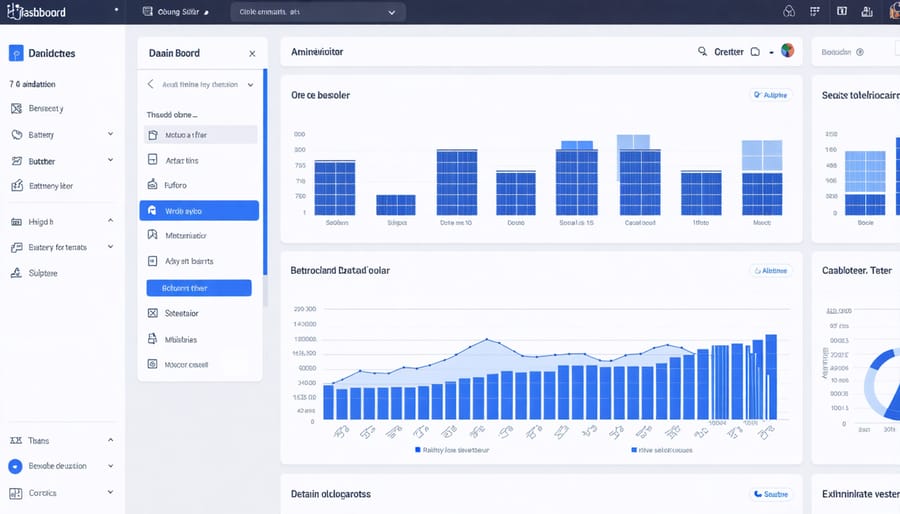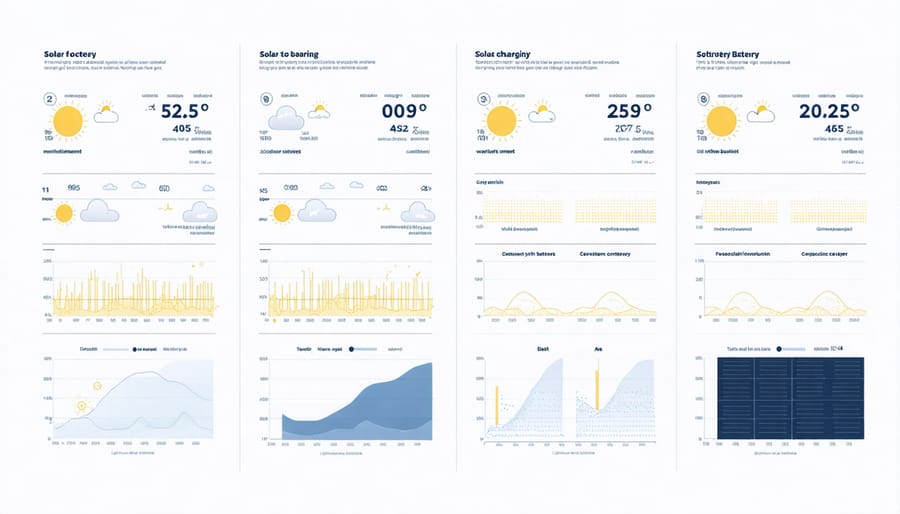Smart Energy Storage: How AI Predicts and Optimizes Your Solar Battery Performance

Data science and predictive analytics are revolutionizing solar energy storage, transforming raw system data into actionable intelligence that drives efficiency and cost savings. Through advanced algorithms and AI-powered storage management, modern solar installations can now forecast energy demand patterns, optimize storage capacity, and automatically adjust performance parameters in real-time.
European businesses leveraging these technologies report up to 30% improvements in storage efficiency and significant reductions in operational costs. By analyzing weather patterns, historical usage data, and grid demand fluctuations, predictive models enable precise energy distribution and storage strategies tailored to each installation’s unique requirements.
The integration of machine learning algorithms with solar storage systems represents a crucial advancement in renewable energy management, particularly for the European market where variable weather conditions and complex grid requirements demand sophisticated optimization solutions. This technology not only enhances system performance but also provides valuable insights for long-term planning and investment decisions in sustainable energy infrastructure.
The Power of Predictive Analytics in Solar Storage
Real-Time Data Collection and Analysis
Modern solar storage systems are equipped with sophisticated sensors and monitoring devices that continuously collect vital operational data. These systems track multiple parameters including energy generation rates, storage levels, consumption patterns, and environmental conditions in real-time. Advanced algorithms process this information, creating detailed performance profiles and identifying optimization opportunities.
The data collection points typically include inverter outputs, battery charge states, grid interaction metrics, and weather conditions. This comprehensive monitoring enables system operators to analyse performance trends and predict potential issues before they arise. Smart meters and IoT devices further enhance this capability by providing granular consumption data at various time intervals.
European energy management platforms are increasingly incorporating artificial intelligence to process this wealth of data. These systems can predict peak demand periods, optimize charging cycles, and automatically adjust system parameters for maximum efficiency. The analysis also helps in predictive maintenance, reducing downtime and extending system lifespan.
For homeowners and businesses, this translates to actionable insights delivered through user-friendly dashboards, enabling informed decisions about energy usage and storage strategies. This data-driven approach has shown to improve overall system efficiency by 15-20% in typical installations across Europe.

Machine Learning Models in Battery Management
Modern battery management systems are increasingly leveraging machine learning algorithms to revolutionize energy storage efficiency. These sophisticated models analyze vast amounts of operational data to predict battery behavior and optimize performance across different usage scenarios.
By continuously monitoring factors such as temperature, charge cycles, and usage patterns, AI algorithms can accurately forecast battery degradation and recommend optimal charging strategies. This predictive capability enables system operators to extend battery lifespan while maintaining peak performance levels.
The models employ various techniques, including neural networks and gradient boosting, to learn from historical data and adapt to changing conditions. For example, they can automatically adjust charging parameters based on weather forecasts and expected energy consumption patterns, ensuring maximum efficiency during peak solar production periods.
European energy storage facilities are already seeing impressive results, with AI-optimized systems showing up to 20% improvement in battery longevity and a significant reduction in operational costs. These innovations are particularly valuable for residential and commercial installations, where maximizing return on investment is crucial.
Optimizing Energy Storage Through Smart Predictions
Weather Pattern Integration
Modern solar energy systems leverage sophisticated weather forecasting data to optimize storage decisions and maximize energy efficiency. By integrating real-time meteorological data with historical weather patterns, these systems can predict upcoming weather conditions with remarkable accuracy, allowing for smarter energy management decisions.
The process begins with the collection of detailed weather forecasts, including cloud cover predictions, temperature variations, and precipitation probabilities. Advanced algorithms then analyze this data alongside historical performance metrics to create precise energy generation forecasts. This integration enables storage systems to make proactive decisions about when to store excess energy and when to utilize stored reserves.
For example, when the system predicts several cloudy days ahead, it can automatically prioritize energy storage during available sunny periods. Conversely, if clear weather is forecasted, the system might opt to use more stored energy during peak price periods, knowing it can replenish reserves soon.
In European climates, where weather patterns can be particularly variable, this predictive capability proves especially valuable. Cities like Munich and Amsterdam have reported efficiency improvements of up to 25% in solar storage systems utilizing weather pattern integration. The technology also helps mitigate the impact of seasonal variations, ensuring more consistent energy availability throughout the year.
These weather-aware systems continuously learn and adapt, improving their prediction accuracy over time and contributing to more sustainable and cost-effective solar energy solutions.

Consumption Pattern Analysis
Modern solar energy systems leverage sophisticated consumption pattern analysis to maximize efficiency and reduce waste. By analyzing historical usage data, advanced algorithms can identify trends, peaks, and valleys in energy consumption across different time scales – from daily routines to seasonal variations. This data-driven energy optimization enables systems to predict future energy needs with remarkable accuracy.
The analysis typically examines factors such as household occupancy patterns, appliance usage schedules, and weather conditions to create detailed consumption profiles. These profiles help optimize energy distribution by ensuring storage systems charge during low-demand periods and discharge during peak usage times. For European households, this means better utilization of solar energy, particularly during shorter winter days when generation capacity is limited.
Machine learning algorithms continually refine these predictions by incorporating real-time data, adapting to changing consumption patterns, and accounting for special events or holidays. This dynamic approach allows for smarter energy management decisions, such as automatically adjusting storage capacity based on forecasted demand or suggesting optimal times for high-energy activities.
For businesses and industries, consumption pattern analysis provides valuable insights for capacity planning and cost reduction. The system can identify opportunities for load shifting, suggest maintenance schedules during low-demand periods, and help maintain optimal power quality throughout the distribution network.
Grid Integration Intelligence
Modern energy storage systems leverage sophisticated data analytics to optimize their interaction with the power grid, creating a more intelligent and responsive energy ecosystem. These systems continuously analyze patterns in energy production, consumption, and grid demands to make informed decisions about when to store, release, or trade energy.
By processing real-time data from multiple sources, including weather forecasts, electricity prices, and historical usage patterns, storage systems can predict optimal charging and discharging cycles. This intelligence enables homeowners and businesses to maximise self-consumption of solar energy while maintaining grid stability.
In the European context, where grid regulations and energy markets vary by country, these systems adapt their strategies based on local conditions. For instance, in Germany, where dynamic electricity pricing is common, storage systems can automatically charge during low-price periods and discharge during peak pricing, generating significant cost savings.
The integration of machine learning algorithms further enhances this capability by continuously improving prediction accuracy. These systems learn from past performance, grid events, and seasonal variations to fine-tune their operation. For commercial installations, this translates into reduced peak demand charges and improved return on investment.
Grid operators benefit as well, as intelligent storage systems can respond to grid stress signals, providing valuable flexibility services. This cooperative approach between storage systems and the grid creates a more resilient and efficient energy network, supporting Europe’s transition to renewable energy.
Real-World Benefits for European Users

Residential Success Stories
In Munich, Germany, the Schmidt family’s smart home installation showcases the power of predictive analytics in residential solar systems. By implementing advanced data analysis, their system accurately forecasts daily energy consumption patterns, automatically adjusting storage and usage for optimal efficiency. Within six months, the Schmidts reported a 28% reduction in grid dependency and a 35% decrease in energy costs.
A community project in Copenhagen demonstrates how collective data insights drive success. Twenty households participated in a shared solar storage network, where predictive algorithms optimized energy distribution based on individual consumption patterns. The system’s machine learning capabilities helped reduce peak demand by 40% and improved overall solar utilization by 25%.
In Amsterdam, the Van der Meer residence combines weather forecasting with consumption analysis to maximize solar efficiency. Their smart system predicts cloudy periods and automatically adjusts energy storage levels, ensuring consistent power supply during less productive hours. This implementation resulted in 92% solar self-consumption rates during summer months.
The Laurent family in Lyon transformed their heritage home into a modern energy-efficient dwelling through predictive analytics. Their system learns from historical usage data, adapting to seasonal changes and family routines. The installation achieved payback within four years, exceeding initial projections by 18 months thanks to intelligent energy management and storage optimization.
These success stories demonstrate how data-driven solutions are revolutionizing residential solar energy management across Europe, delivering tangible benefits through smarter energy decisions.
Commercial Applications
Data science and predictive analytics have revolutionised how European businesses optimise their solar energy systems. Leading German manufacturer SolarTech GmbH implemented predictive maintenance algorithms across their solar panel production lines, reducing downtime by 35% and improving overall manufacturing efficiency by 28%.
In the Netherlands, major retail chain EcoMart deployed advanced analytics to optimise energy consumption across 200 stores. Their system analyses weather patterns, foot traffic, and historical energy usage to automatically adjust solar storage systems, resulting in a 25% reduction in grid dependency and significant cost savings.
Spanish agricultural cooperative ValenciaSol uses predictive analytics to maximise solar irrigation efficiency. Their smart system processes soil moisture data, weather forecasts, and crop growth patterns to optimise water pumping schedules, achieving 40% energy savings while maintaining optimal crop yields.
French logistics company TransportVert implemented machine learning algorithms to predict fleet charging demands based on delivery schedules and route optimisation. This integration with their solar-powered charging stations has improved fleet efficiency by 32% and reduced peak load demands by 45%.
Danish smart city project CopenhagenSmart demonstrates how predictive analytics can orchestrate solar energy distribution across urban infrastructure. Their system manages energy flow between public buildings, street lighting, and EV charging stations, achieving 30% better energy utilisation compared to traditional systems.
Future-Proofing Your Energy Storage Investment
As we look towards the horizon of energy storage technology, data science and predictive analytics are revolutionising how we approach future-proof energy storage solutions. The integration of artificial intelligence and machine learning algorithms is enabling unprecedented levels of storage optimisation and system longevity.
One emerging trend is the development of self-learning systems that can anticipate energy demand patterns with increasing accuracy. These systems analyse historical usage data alongside real-time weather forecasts, local energy prices, and grid conditions to optimise charging and discharging cycles automatically. This intelligent management not only extends battery life but also maximises return on investment.
Advanced degradation monitoring is another crucial development. Modern analytics platforms can now predict battery health with remarkable precision, allowing system owners to take preventive measures before issues arise. This predictive maintenance approach is particularly valuable for commercial installations where downtime can be costly.
The European Union’s push towards standardised energy data sharing is creating new opportunities for cross-system optimisation. Smart meters and IoT sensors are becoming increasingly sophisticated, providing granular data that helps refine predictive models and improve overall system performance.
Looking ahead, we’re seeing the emergence of blockchain technology for peer-to-peer energy trading, which will require even more sophisticated predictive capabilities. This technology will enable communities to share stored energy more efficiently, creating local energy markets that benefit from precise supply and demand forecasting.
To ensure your investment remains valuable, consider systems that offer:
– Regular software updates and algorithm improvements
– Integration capabilities with emerging smart grid technologies
– Scalable storage capacity to accommodate future needs
– Compatibility with various energy management platforms
– Support for multiple communication protocols
By focusing on these aspects, you’ll be better positioned to adapt to new developments in predictive analytics and energy storage technology, ensuring your system remains efficient and valuable for years to come.
The integration of data science and predictive analytics into energy storage systems represents a significant leap forward in solar energy management. By leveraging these advanced technologies, European homeowners and businesses can achieve remarkable improvements in system efficiency, cost savings, and overall energy independence.
Through predictive analytics, users can anticipate maintenance needs, optimize energy consumption patterns, and make informed decisions about storage capacity utilization. This proactive approach not only extends system longevity but also maximizes return on investment, making solar energy storage more accessible and financially viable for a broader range of users.
The benefits are clear: reduced operational costs, enhanced system reliability, and improved energy management capabilities. European installations implementing these solutions have reported up to 25% increases in system efficiency and significant reductions in unexpected downtime. Additionally, the integration of smart analytics supports the continent’s ambitious sustainability goals while providing tangible economic advantages to end-users.
As we move towards an increasingly connected and data-driven future, embracing predictive analytics in energy storage systems is not just an option – it’s a necessity for staying competitive and environmentally responsible. We encourage all stakeholders to explore these innovative solutions and consider implementing them in their solar energy systems. The technology is mature, the benefits are proven, and the support infrastructure is in place across Europe to help you succeed in this transformation.
Take the first step towards smarter energy management today by incorporating these powerful analytical tools into your energy storage strategy.
Leave a Reply